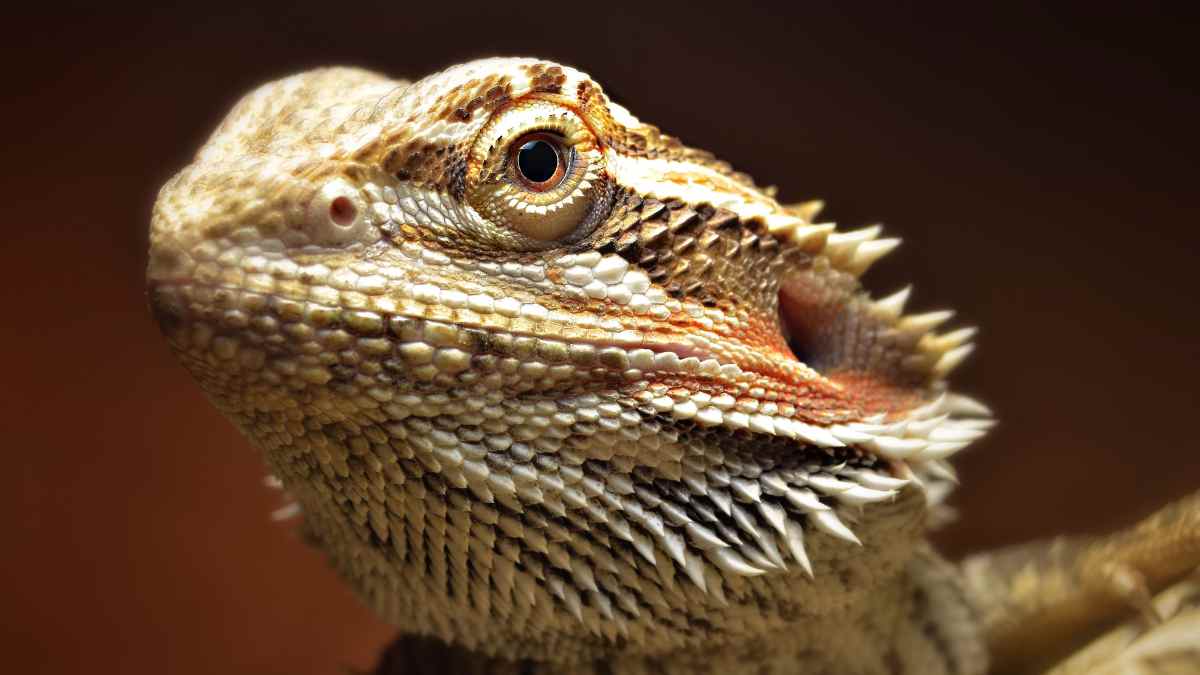You may have heard of the classic gecko or even the iconic iguana, but did you know dozens of incredible reptile species now make great pets?
From African fat-tailed geckos to fancy Chinese water dragons, the world of lizards is full of variety and fascination. Even if you’ve never owned a pet lizard before, don’t worry! With years of experience and the right supplies, any experienced pet owner can soon make a pet lizard a beloved family member.
Whether you’re a first-time pet lizard enthusiast or a hardened reptile pro, this list of popular pet lizards is sure to help you make the right choice. Discover the different personalities and habits of each of these incredible creatures, so keep reading, and you’ll find the perfect new scaly addition for your family.
Let’s jump into the fascinating world of pet lizards!
7 Popular Pet Lizard Breeds
1. Bearded Dragon

The little reptile they call the bearded dragon, fondly known as beardies, is undoubtedly one of the most popular pet lizards to keep as companions. Although these cuddly little buggers look intimidating initially, their friendly, playful nature will put you at ease in no time!
Beardies thrive on attention, making them the perfect pet for anyone looking for companionship. At first, they may be a little shy and slow to warm up to you, but don’t be fooled: Once they get used to your voice, they’ll draw closer and closer, eventually hopping onto your arm, requesting your constant attention! These friendly little dragons are known to be excellent climbers and explorers, so it’s essential to give them enough room to roam and explore.
To enhance your bearded dragon’s quality of life, it’s imperative to ensure they have the right conditions to stay healthy. Bearded dragons enjoy warm and dry climates, so regular misting and temperature regulation are essential. Also, the proper lighting and nutrition are necessary to keep your bearded dragon healthy and strong!
The good news is, they eat almost anything – from crickets to earthworms, and even fruits and veggies every once in a while.
-

Beaded Dragon Fan Exclusive: ‘Original Hipster’ T-Shirt – Wear Your Unique Style with Pride – Unisex t-shirt
£13.00 – £20.50 Select options This product has multiple variants. The options may be chosen on the product page -

Chinese Water Dragon Aquatic Mastery Tee: Dive into Elegance with Our Exclusive Reptile Enthusiast Shirt – Unisex t-shirt
£13.00 – £20.50 Select options This product has multiple variants. The options may be chosen on the product page
Although caring for such a unique creature may be intimidating, the rewards are worth the effort.
2. Leopard Gecko
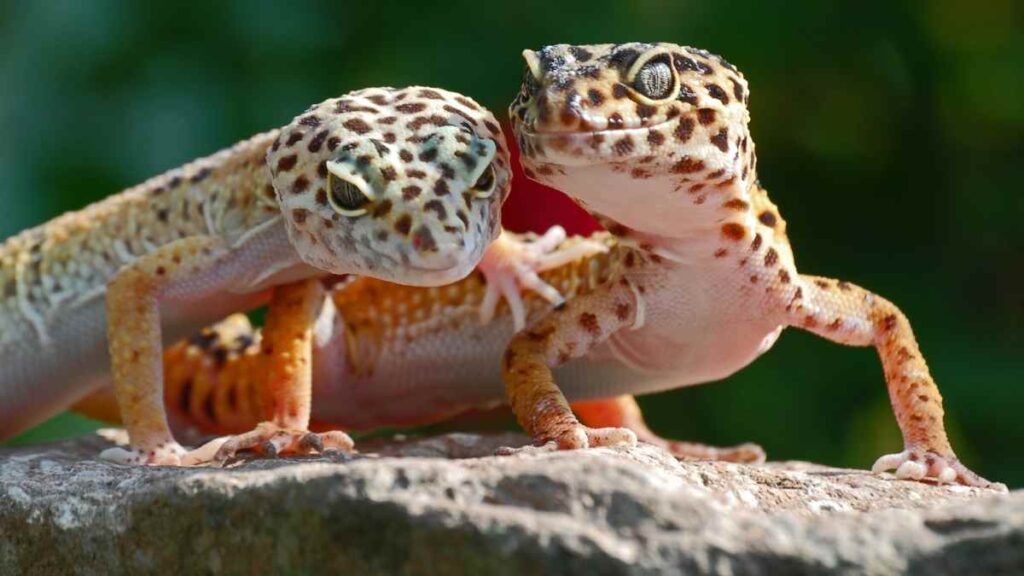
If you’re looking for an interactive pet with a unique style and a surprising personality, you’ll want to consider a leopard gecko. They come with an unmistakable patterning, allowing you to pick out your special patterned friend.
Leopard geckos have personalities all their own, and each one is different. They’re also eager for attention, wanting to explore your hand and your home. They’re also easy to take care of, as they require minimal effort, making them an excellent option for anyone looking for a beginner lizard.
If you want to get creative with your gecko’s setup, you can join the leopard gecko tank decoration game. Using items like hide boxes and rocks, you can make their quiet, dark cave-like enclosure look like the kind of lair your cold-blooded buddy deserves.
Plus, their food, which consists of crickets, mealworms, and super worms, is widely available and easy to have. So, no more worrying about running out to the pet store at 10 pm because your gecko needs to eat!
Leopard geckos are nocturnal and spend the day sleeping in their hide boxes. You won’t see them during the day, so if you want to show them off, you can do so at night. Give them a light source and watch their day-sleeping bodies come alive as they emerge from their hiding spots to explore, search for food, and socialize with others.
If you’re looking for a low-maintenance pet with personality, consider the leopard gecko. With their unique patterning, friendly temperament, and easy-care requirements, this spotty lizard will make your day a little brighter.
3. Crested Gecko
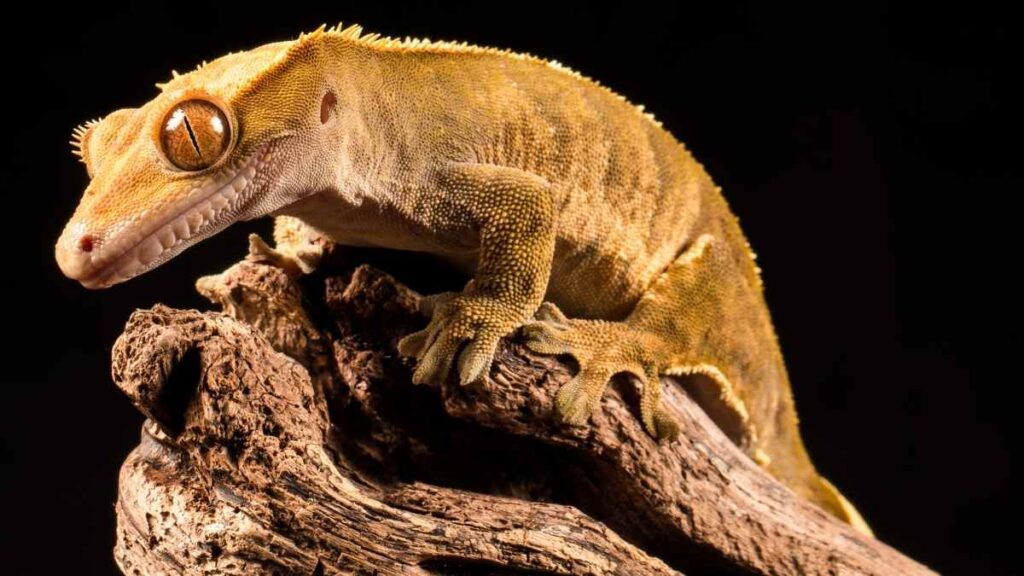
Crested geckos are a popular pet lizard breed that comes in vibrant colors. They’re relatively beginner friendly and fairly small compared to other reptile species. On average, they have a 15-20 years lifespan and can reach up to 8-10 inches long.
Crested geckos may require a heated terrarium to get their ideal temperature of 75℉, but their diet might not require all the fancy crickets the pet store sells; a crestie diet of pureed fruits, vegetables, and insect-based protein is doable. Plus, if you’re ever feeling slightly intimidated, there’s loads of information online about properly caring for one!
One bonus about crested geckos is that they’re natural climbers. So if you’ve got enough room and some pre-planned decorations, they’ll have a blast crawling around, in and out of the branches, and sometimes taking a nap.
Besides being active, crested geckos are also quite shy, so it’ll take some time and patience to get them to warm up to you. If you’re patient and give them their space, they’ll eventually trust you, want to be around you, and even let you hold them.
While crested geckos are considered an ideal starter reptile, it’s important to research the kind of commitment caring for one requires. Your crested gecko will be happy and healthy for years with proper care.
4. Tokay Gecko
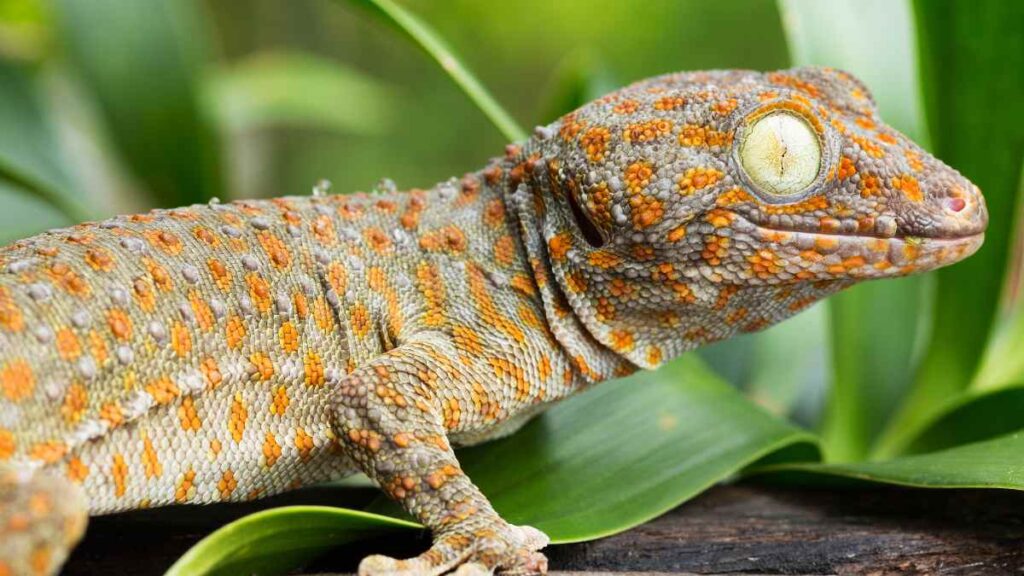
A Tokay Gecko can instantly capture your attention with its eye-catching colors and larger-than-life personality. The reptiles have an iconic look, with a bright blue and orange pattern covering their bodies and a bright red streak that runs along their back. These reptiles brighten up a room, and their tails can also detach to help them escape predators!
One of the unique aspects of a Tokay Gecko is its voice. Think of Pikachu’s “Pika Pika”; now imagine a creature that’s essentially a 6-inch-long live Pikachu! Tokay Geckos make a loud, raspy “GECK!” noise. They communicate with each other and are generally more active than other lizards at night – so you may have to adjust your sleep schedule accordingly.
If you’ve got the patience, you’ll be well-rewarded in the end. These geckos are smart, curious, and very interactive, and many owners like to train their Tokays to accept food from their hands. That’s a great way to build a relationship between you and your reptile.
The Tokay Gecko diet is simple; they enjoy protein-rich insects like crickets and mealworms. They’ll also appreciate treats now and again (cooked surface shrimp being a big hit). But make sure to quarantine feeders for a few days to ensure they don’t have parasites!
Tokay Geckos are great starter lizards but make sure you have the knowledge to care for these incredible creatures. Research their temperatures, humidity, and diet requirements and build their enclosure accordingly. Keeping an eye out for any signs of illness is also essential.
Tokay Geckos make a spectacular pet, and you can expect loads of entertainment when you have one in your home. With the right care, they can live up to 10 years – plenty of time to build a strong bond with your reptilian buddy!
5. Blue Tongue Skink
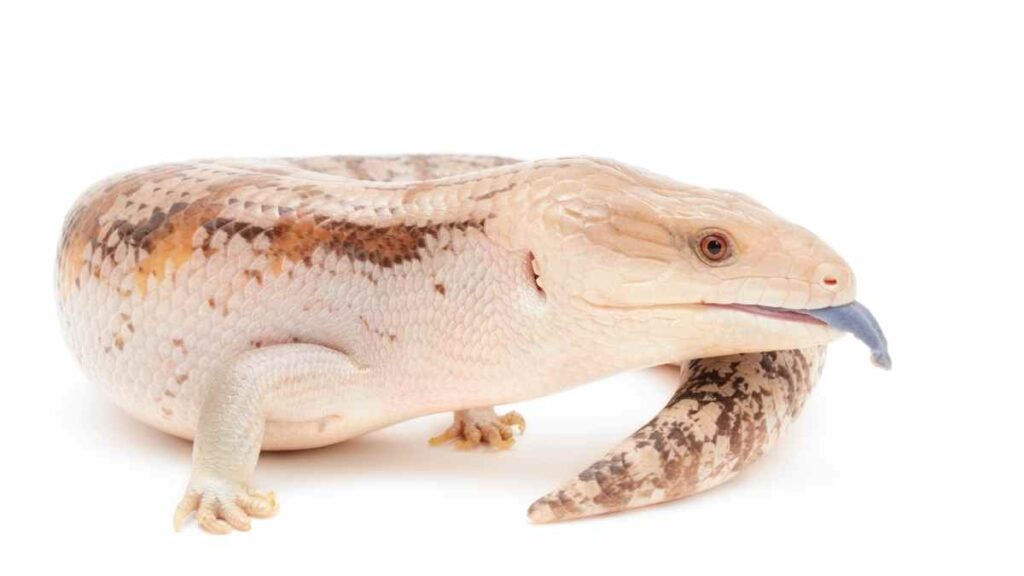
This iconic Aussie-native species is the perfect out-of-the-ordinary pet for folks who love to show off their exotic pet skills. Used to a dry habitat and medium-level maintenance, the blue tongue skink is a unique pet with stunning features.
First of all, aren’t they just breathtakingly gorgeous? Their diamond-patterned bodies with bluish-gray scales add a charm that makes them stand out from the other lizard communities. In fact, they’re a fan favorite due to their bright blue tongues (hence the name).
Having a blue tongue skink as your pet comes with a unique responsibility. They are well-known to bond deeply with their owners, so it’s important to consider how much time you’re willing to commit to them. The skinks need to be handled with gentle hands and will often act like lap lizards. Fun fact: you may even spot your friendly skink snuggling up to you for warmth during winter months!
To meet their dietary demands, it’s important to remember to include fruits and vegetables as a regular source. A mixture of fruit flies and meal worms is known to work its magic on any blue tongue skink. But don’t forget that it’s beneficial to give some supplements like calcium and vitamin D3. A healthy diet goes a long way with these guys!
Blue-tongued skinks are undeniably cute and will maintain that special edge when choosing a pet. Unlike other species, they make an ideal pet for those seeking an exciting companion or pet lizard. But, if you’re looking for an exotic pet that’s easy to keep and maintain, you can’t go wrong with the blue tongue skink.
6. Argentine Black and White Tegu
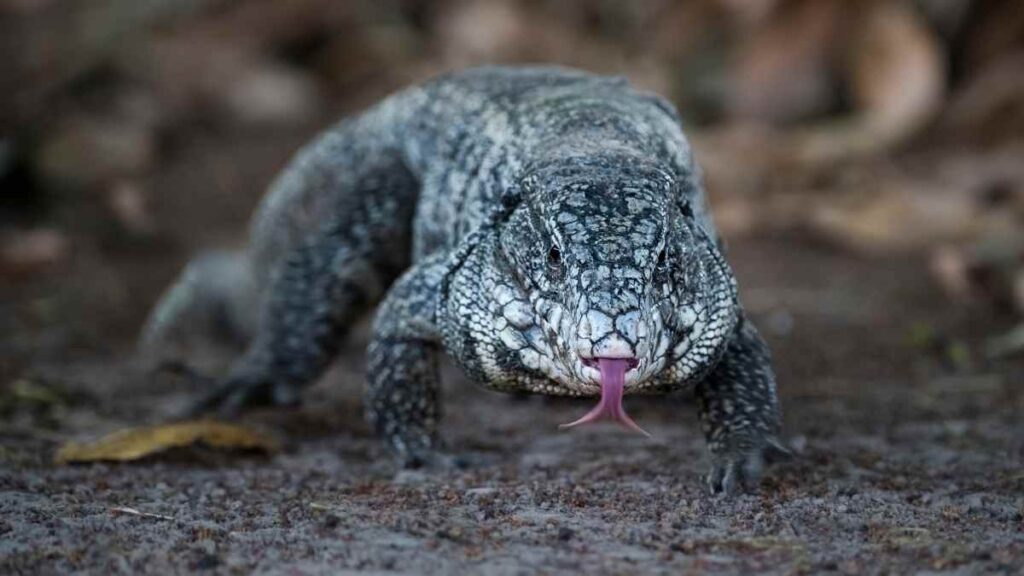
Known for their bold personalities and intelligent behavior, these stunningly beautiful lizards are sure to capture your heart! Even though they can size up to four feet long, they are surprisingly easy to care for.
These beloved scaly friends require a generous habitat, as they have plenty of space to explore and express their curious personalities. A 140-gallon tank or larger is recommended, as they have lots of energy and need the extra space to stretch out and bask in the sun. You’ll also need to ensure their environment is between 79 and 84 degrees Fahrenheit, with consistent and natural UVB rays to keep them healthy and happy.
Regarding feeding, Argentine Tegus enjoy a variety of meats and vegetables. Protein should make up the bulk of their diet, including crickets, mealworms, and pinky mice. For vegetables, a mixture of greens such as collard and turnip greens, green beans, and zucchini are sure to be favorites. As treats, tegus love oranges, apples, mangoes, and grapes.
These high-energy lizards also love plenty of playtimes, from exploring their enclosure to going outdoors with you. They are social creatures who will develop strong bonds with their owners, as they can recognize people, locations, and even certain foods! If you have time and energy to provide to an Argentine Tegu, you’ll be rewarded with an adorable, devoted reptilian friend!
If you are considering an Argentine Black and White Tegu as a pet lizard, research and be prepared to give your tegu the best care possible. With the right know-how and care, they can make an excellent choice as a much-loved reptilian companion!
7. Uromastyx
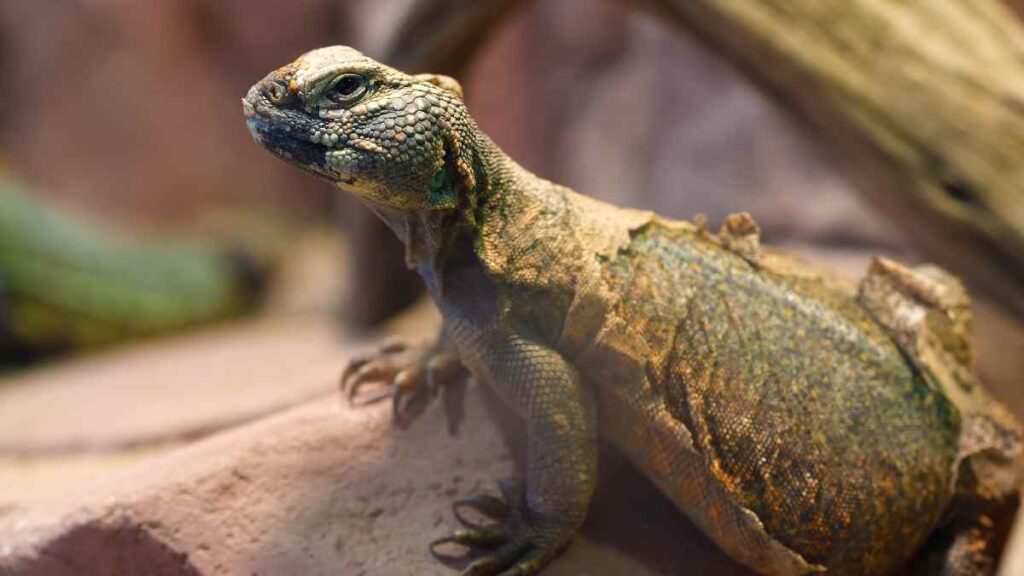
Unlike some other lizards, Uromastyx is pretty docile. But don’t let that fool you – they can still be quite the character. With their trusty pigtails, vibrant coloration, and spiny crests, Uromastyx are sure to add character to any home – especially when they try and play tag with your toes!
Their diet can take a bit of getting used to; these lizards are omnivorous! They’re just as happy grazing on fresh greens as munching on a crunchy cricket snack. Some keepers even add the occasional boiled egg or piece of meat to their menu – yum!
Uromastyx certainly isn’t shy when it comes to its environment. These lizards love to bask in the warm sun and need plenty of time and space to dig, burrow, and explore. A good, deep substrate with plenty of hiding spots is essential for them to feel safe and relaxed.
Uromastyx can be rewarding and highly interactive pets, given the right environment and husbandry. They’re particularly attached to their keepers and can be great conversation pieces – so don’t forget to snap a few pictures to share with your friends!
So, if you’re looking for a pet with an impressive personality to match its remarkable appearance, don’t overlook the Uromastyx. With the proper environment and care, they’re sure to make a colorful, interesting addition to any home.
Conclusion
Everyone has different preferences regarding pets, but lizards can make wonderful companions. Popular pet lizard breeds include bearded dragons, anoles, geckos, iguanas, and skinks, to name a few.
These five species are the perfect fit for those looking to venture into reptile pet ownership! Lizards are fascinating to watch as they explore their environments and offer unique companionship. Plus, despite their sometimes intimidating appearance, lizards are pretty docile and are even known to exhibit behaviors suggesting affection when handled properly and given the right environment and care.
So, if you’re looking for an interesting and laid-back pet, consider giving one of these seven popular pet lizards a chance!
References:
- McGee, Philip. “Caring for a Bearded Dragon.” Wikihow, 2020, www.wikihow.com/Care-for-a-Bearded-Dragon.
- Kesic, Matej. “Bearded Dragon Care: Size, Lifespan, Diet, and More.” Healthline, 3 Oct. 2019, www.healthline.com/health/pet-health/bearded-dragon-care.
- Husband, B. (2020). 10 Facts You Should Know Before You Get a Blue Tongue Skink. Retrieved From: https://uniquepetswiki.com/10-facts-you-should-know-before-you-get-a-blue-tongue-skink/
- Blue Tongue Skink Care Sheet. (2020). Retrieved from: https://www.rainforesttrust.org/blue-tongue-skink-care-sheet/

